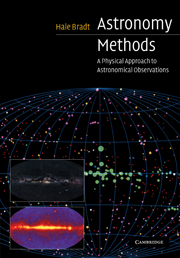Book contents
- Frontmatter
- Contents
- List of figures
- List of tables
- Preface
- Acknowledgments
- 1 Astronomy through the centuries
- 2 Electromagnetic radiation
- 3 Coordinate systems and charts
- 4 Gravity, celestial motions, and time
- 5 Telescopes
- 6 Detectors and statistics
- 7 Multiple telescope interferometry
- 8 Point-like and extended sources
- 9 Properties and distances of celestial objects
- 10 Absorption and scattering of photons
- 11 Spectra of electromagnetic radiation
- 12 Astronomy beyond photons
- Credits, further reading, and references
- Appendix: Units, symbols, and values
- Index
3 - Coordinate systems and charts
Published online by Cambridge University Press: 05 June 2012
- Frontmatter
- Contents
- List of figures
- List of tables
- Preface
- Acknowledgments
- 1 Astronomy through the centuries
- 2 Electromagnetic radiation
- 3 Coordinate systems and charts
- 4 Gravity, celestial motions, and time
- 5 Telescopes
- 6 Detectors and statistics
- 7 Multiple telescope interferometry
- 8 Point-like and extended sources
- 9 Properties and distances of celestial objects
- 10 Absorption and scattering of photons
- 11 Spectra of electromagnetic radiation
- 12 Astronomy beyond photons
- Credits, further reading, and references
- Appendix: Units, symbols, and values
- Index
Summary
What we learn in this chapter
Stars are located on the sky with two angular coordinates. Distances to them may be ignored by visualizing all of them as being on a celestial sphere at “infinite” distance. The angular coordinates define the star's location on the sphere. Any number of coordinate systems can be defined on this sphere. Astronomers use the equatorial, galactic, ecliptic, and horizon systems. The coordinates of a star differ from coordinate system to coordinate system so transformations between them are needed. In the equatorial system, the coordinates of a given star vary steadily and slowly due to precession of the earth, so one must define the epoch, e.g., J2000.0, of any quoted coordinates. “Areas” on the sky are defined as solid angles. Cataloging of stars is accomplished through photographic surveys, printed sky charts, and printed lists (“catalogs”). Unnamed stars can be specified unambiguously by marking the star on a finding chart, a sky photograph of the local region. The name of a star or galaxy may depend on its location and brightness within a constellation, its equatorial coordinates (“telephone number”), or simply its sequential number in a published catalog of objects together with the catalog name, e.g., Messier 42 is the Orion nebula.
Introduction
A casual look at the sky confronts one with uncountable pinpoints of light. It is imperative that we be able to refer to particular celestial objects without waiting for a cloudless and moonless night.
Information
- Type
- Chapter
- Information
- Astronomy MethodsA Physical Approach to Astronomical Observations, pp. 34 - 56Publisher: Cambridge University PressPrint publication year: 2003
